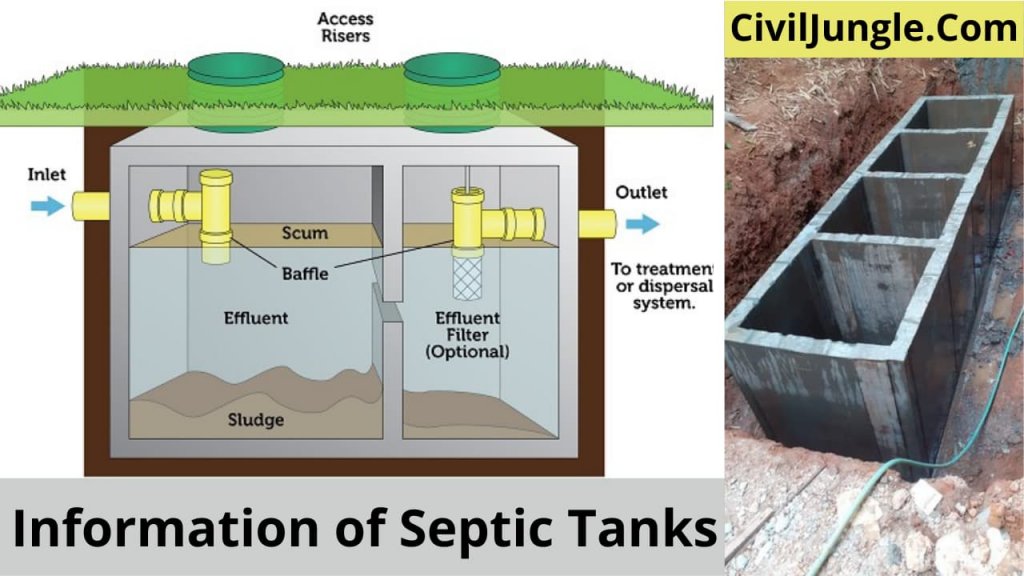
Information of Septic Tanks System
A septic tank is basically an underground structure that is made from concrete, plastic, or fiberglass. The main function of the septic tank is to store the domestic sewage for primary treatment.
A septic tank is also known as a sewage collection tank which is commonly used in the areas where there is a connection to the main sewerage pipes are available.
One of the common problems with septic tanks is that they will create a nuisance and awful smell of sewage in your entire house which makes unhealthy conditions.
This is most likely due to the septic tank get full or damaged due to which wastewater gets out of it and creates an awful smell in the surrounding.
This issue must be fixed as early as possible. Here, in this article, you will get to know all about a septic tank, how much does it cost to pump a septic tank and all about septic tank repair, maintenance, and Septic Pump Replacement Cost.
Why Septic Tanks Required Pumping?

In the septic tank, the sludge gets deposited at the bottom of the tank with time and if it is not pumped regularly then it gets leaked or back up through the pipes. So, it is necessary that the septic tanks should be regularly pumped, clean, and maintain.
The septic tanks are designed for a definite number of persons and with time the number of persons gets increased which ultimately increases the load on the septic tank due to which it gets full and may be leaked.
Septic tanks can last for many years but the condition is that they should be well maintained and pumped out regularly.
If the septic tank is not regularly pumped then it will get full and overflow which causes unpleasant conditions and it may clog the drains and the venting systems. The septic tank should be cleaned regularly to avoid the sludge buildup in the septic tank.
Typical Problems Leading to Septic Tank Pumping
There are various problems that lead to the septic tank pumping that are as follows
- With time, sludge and scum get concentrated in the septic tank.
- Due to heavy rainfall which increases the water table.
- The drainage pipe gets damaged due to which the water rises too high in the septic tank and pushes the sewage into the drains.
- The pipes inside the fixtures get clogged.
- The level of the sludge and scum is high due to which it leaves the septic tank and enters the drain field.
Septic Tank Cleaning Cost

The cleaning of the septic tank is very important to keep the septic tank in working condition.
It is necessary that the septic tank should be cleaned regularly which will reduce the maintenance and the repair cost and also increase the durability of the septic tank.
Here we have given the chart of the septic tank cleaning cost that will give you an idea of the cost required to clean the septic tank of your house.
| Size of the Septic tank | Septic Tank Cleaning Cost |
| Pumping of the septic tank of volume 750 gallon | $ 250 |
| Pumping of the septic tank of volume 1000 gallon | $ 375 |
| Pumping of the septic tank of volume 1250 gallon | $ 475 |
| Repairing of the septic tank or replacement of the filter
(optional) |
$ 200-350 |
| Repairing of the other parts of the septic tank (optional) | $ 50-400 |
The cost of cleaning the septic tank varies from place to place and depends upon the size of your septic tank. You can do an inquiry on Septic Tank Pumping Cost Near You so that you can clean your septic tank.
Septic Tank Repair Cost

The repair of the septic tanks depends upon the defect and how much area of the septic tank should be repaired. Here are some of the most common damages and repairs are done for the septic tank are as follows.
1. Septic Tank Pump

The average price for the replacement of the septic tank pump ranges from $ 500 to $ 1400. It depends upon the type and the quality of the pump you are using for your septic tank.
2. Septic Tank Baffle

The septic tank baffles are located at the junctions where the pipes enter and exit in the septic tank. The baffle which is at the inlet pipe is known as the inlet baffle and the other which is at the outlet pipe is known as the outlet baffle.
The baffles are the important part of the septic tanks that directs wastewater through the septic tank. The average cost of the baffle is around $ 20 to $ 50.
3. Septic Tank Lid

The lid of the septic tank is available in the market of various materials. The concrete lid may get cracked and the steel lid gets rust. The cost of the lid of the septic tank ranges from $ 40 to $ 60.
4. Septic Tank Filter

The septic tank filter is one of the most common replacements that is done for the septic tank and its cost ranges from $ 230 to $ 300.
5. Drain Field

The drain field of the septic tank can get overload and flood due to which there will be a backup of the sewage in the toilets and sinks. The cost required for the replacement of the drain field is $ 3,500 to $ 10,000.
Septic Tank Repair Cost by Type of Repair

The Septic Tank System Cost depends upon the following factors that are as follows.
| Type of Repair |
Average cost |
| Septic Tank pump | $ 500 to $ 1400 |
| Septic Tank Baffle | $ 20 to $ 50 |
| Septic Tank lid |
$ 40 to $ 60.
|
| Septic Tank Filter | $ 230 to $ 300 |
| Drain Field | $ 3,500 to $ 10,000 |
How Often Do I Need to Pump My Septic Tank?
The frequency of pumping your septic tank depends upon the size of the septic tank and the number of persons living in your house. It is generally recommended to pump the septic tank every 3-4 years.
It also depends upon the number of persons in your house. If the number of people increases then you have to increase the frequency of pumping a septic tank. The factors that affect the frequency of the septic tank pumping are as follows.
- Size of the Septic tank
- Total wastewater generated daily
- Number of persons living in a house
- The volume of solids in wastewater
When Do I Need a Septic Tank Inspection?
The septic tank inspection is one of the most common methods during the purchasing or selling of any house. The inspection of the septic tank includes checking pests and inspecting the complete septic structure.
The septic inspections play a vital role in keeping the people living in the house safe and healthy. Here are some points that will indicate that you need a septic tank inspection:
- The water from your toilets and bathrooms as well as sink backing up.
- There is a problem with water pooling in the yard of your house.
- There will be some bad smell coming from the plumbing system of your house.
The inspection and the pumping of the septic tank are very important to ensure the proper working of the septic tank.
It is recommended that you should inspect your septic tank every three years, this will reduce some major costs that are required for repairing the septic tanks.
Type of Septic Tank Inspections
There are two types of septic tank inspections that are generally carried on the septic tank that is as follows
1. Visual Inspection of septic tank

This type of Inspection is usually done when the property or the house is going to sell or buy. The inspector checks the water pressure in the house by running water and flushing all the toilets and water closets of the house.
The visual Inspection is very quick but it does not help you to exactly know the condition of your septic tank, because there are some issues in the septic tank that cannot be seen with the naked eye.
2. Full Inspection of septic tank

This is the complete detailed inspection of the septic tank which is done by the experts and they will submit a detailed report of the issues and the remedies that are required to your septic tank.
The experts will also perform a couple of tests to check whether all components are working in good condition or not.
The average Septic System Inspection Cost ranges from $250 to $ 550. The inspection of The Septic Tank Maintenance Cost mainly depends upon the type of maintenance that is required to be done for the septic tank.
How to Keep Safe a Septic System?
The septic tank is one of the most important functional elements of residential structures. The periodic maintenance and repair of the septic tank are necessary to keep the septic tank in efficient working condition.
- Take care while flushing and draining. Avoid flushing of harmful waste such as paint solvents, floor cleaners, and motor oil, etc.
- Avoid the plantation of trees or any other type of plant near your septic tank. Because the roots of the trees can damage the septic system.
- Conserve the water consumption, it will also help you to bill down the water charges and also keep the level of the septic tank in optimum condition.
- Do Periodic maintenance and inspection of the septic tank so that you will fix the issues from time to time.
- Divert Rainwater flow from the septic drain field, will help to avoid the septic tank from overflowing.
- Avoid the use of harmful chemicals as they can pollute the groundwater.
- Dispose of your garbage wisely, because it may clog the drain and affects the working of your septic tank.
What Cleaning Products Can I Use with a Septic Tank?
The right cleaning product should be selected for the cleaning of the septic tank to maintain the bacterial balance.
While selecting the cleaning product, it is important to choose the right one as it will affect your septic tank. Septic tanks use the bacteria to naturally break down the waste present inside them.
If you use wrong or unsuitable products for the cleaning of the septic tank then it can cause various issues such as pollution of the groundwater and clogging of the septic tank.
The septic tanks can handle the low levels of chemicals so it is important that what type of chemicals you are putting inside the septic tank. Here are some of the cleaning products that you can use with a septic tank are as follows
Washing Powder for the Septic Tank
It is recommended to choose the liquid laundry detergent over a powder as sometimes the powder will not break down properly and it can clog the system.
Brands such as Bio D, ecozone, and E-cover are eco-friendly detergents that you can use safely for the cleaning of septic tanks. The multipurpose household cleaners are generally used in septic tanks.
But the multipurpose household cleaners should be phosphate-free as these products do not contain any harmful chemicals that will damage the bacteria present in the septic tank.
What Not to Put in a Septic Tank?
1. Disinfectants
There is a large number of disinfectants such as chlorine, pine oil, phenolic that will kill the bacteria in the septic tank. So that these disinfectants should be used in a limited quantity.
Do not use gasoline, paint thinners, grease in your septic tank. These products do not degrade well and they may affect the other processes in the septic tank.
2. Bleach with a Septic Tank

Bleach also kills bacteria but you can use standard household bleach with the septic tank as it is diluted and not strong enough to kill the bacteria present in the septic tank. Also, avoid the usage of extra strong bleach in the septic tank.
FAQs about Septic Tanks
What Is a Septic Tank and How Does It Work?
A septic tank is an underground system designed to treat and store domestic sewage. It separates solids from liquids, allowing the solids to settle at the bottom and the liquids to flow out to a drain field for further treatment.
How Often Should a Septic Tank Be Pumped?
Septic tanks should generally be pumped every 3-4 years. However, the frequency can vary based on factors like the tank size, the number of people in the household, and the amount of wastewater generated.
What Are the Signs That My Septic Tank Needs Pumping or Repair?
Common signs include slow drains, water backing up into sinks or toilets, foul odors, and water pooling in your yard. If you notice these issues, it’s important to inspect and possibly pump the septic tank.
How Much Does It Cost to Pump a Septic Tank?
The cost of pumping a septic tank varies by size and location. On average, it ranges from $250 to $475. The cost can increase if additional services or repairs are needed.
What Are the Typical Costs for Septic Tank Repairs?
Repair costs vary depending on the issue. Replacing a septic tank pump costs between $500 and $1400, while repairing other components like baffles or filters can cost between $20 and $300. Replacing a drain field can be significantly more expensive, ranging from $3,500 to $10,000.
How Can I Maintain My Septic Tank to Avoid Problems?
To maintain your septic tank, avoid flushing harmful substances like grease, chemicals, and non-biodegradable items. Conserve water, avoid planting trees near the tank, and have the tank inspected and pumped regularly.
What Types of Cleaning Products Are Safe for Septic Tanks?
Use eco-friendly cleaning products and detergents that are low in chemicals. Avoid bleach and disinfectants that can kill the beneficial bacteria in your septic tank. Liquid laundry detergents are generally better than powders.
When Should I Get a Septic Tank Inspection?
It’s recommended to have a septic tank inspection every 3 years, especially when buying or selling a property. Inspections can identify potential issues and help prevent costly repairs.
What Should I Do If My Septic Tank Is Overflowing?
If your septic tank is overflowing, stop using water immediately and contact a professional septic service. An overflow indicates that the tank is full or there is a blockage that needs urgent attention.
How Can I Find a Reliable Septic Tank Service Provider?
To find a reliable septic tank service provider, ask for recommendations from friends or family, check online reviews, and verify the company’s credentials and experience. Make sure they are licensed and insured.

